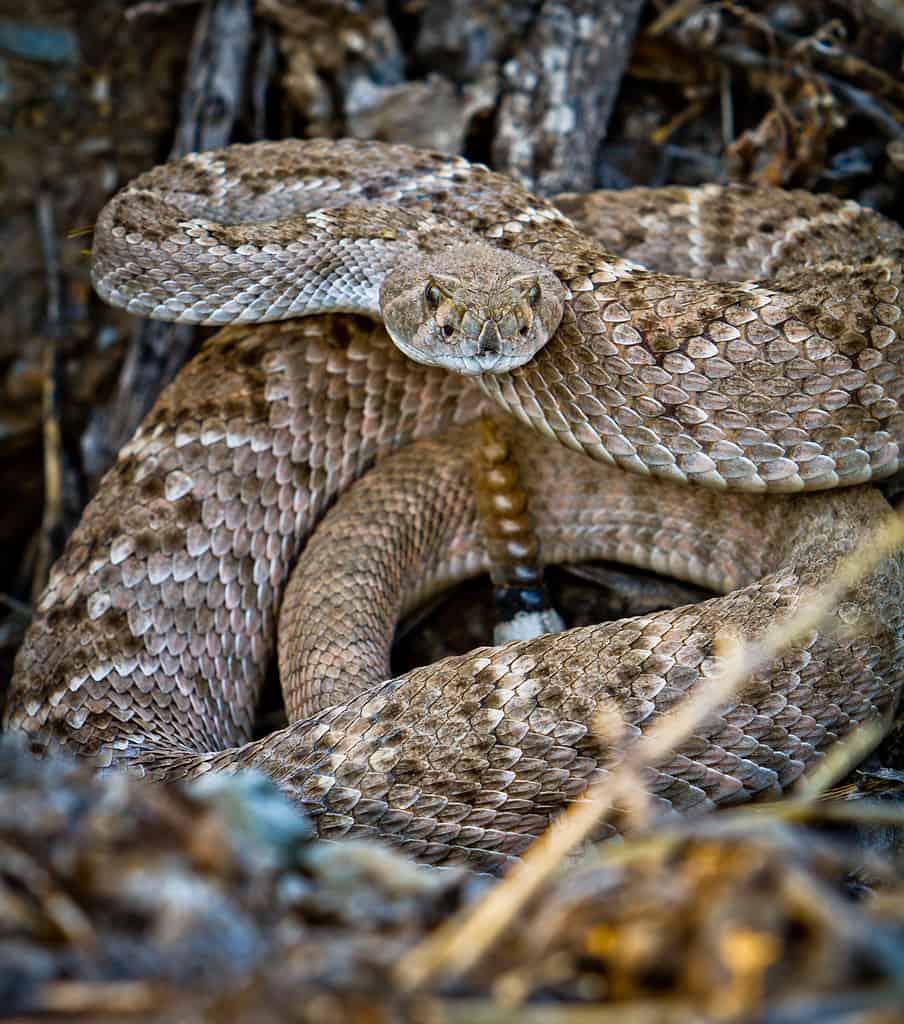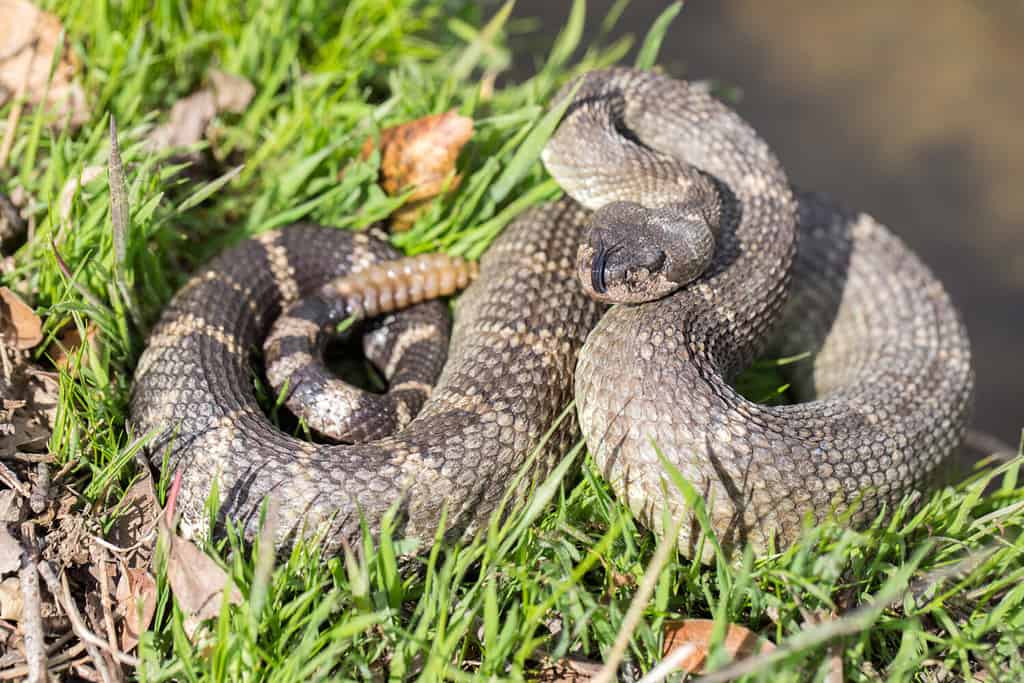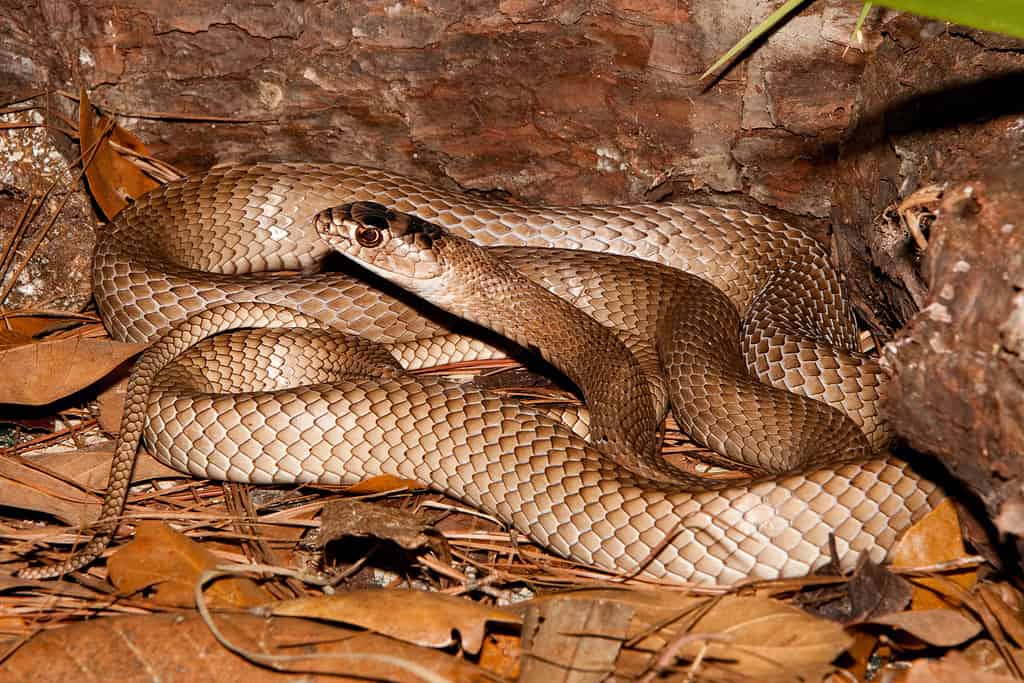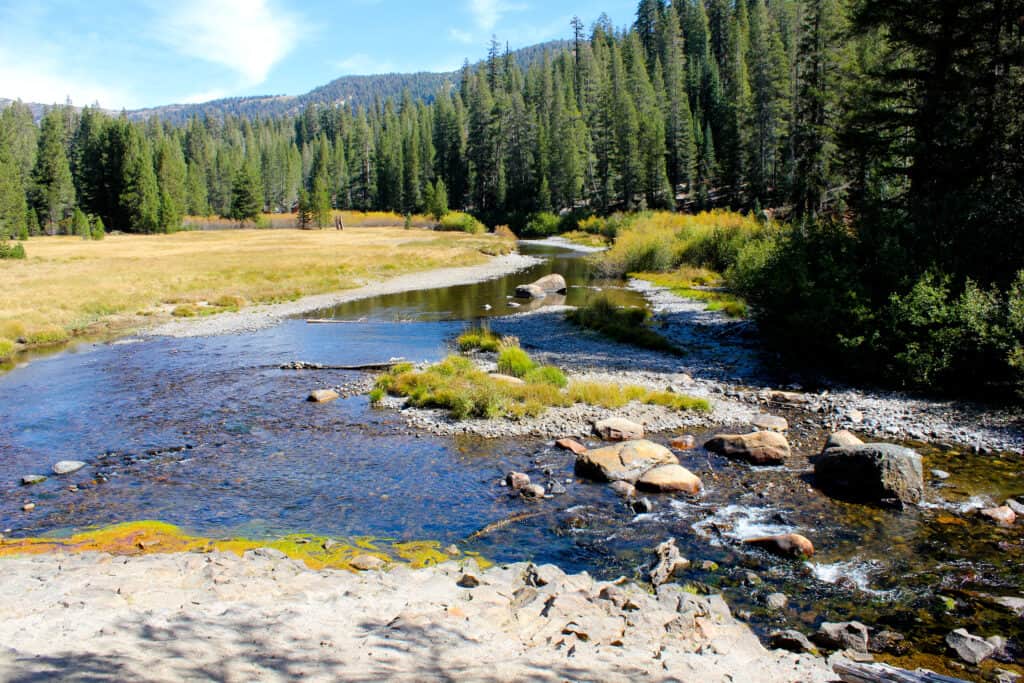The San Joaquin River flows through the Central Valley of California. It flows through fertile valleys, nourishing farmlands and the diverse wildlife around it. Some of this wildlife includes snakes. As you might expect, many of them flock to the river for water, and several live in the river for much of the time.
Several snake species live in California, many of which spend time in and around rivers. Therefore, you can expect to find many snakes in the San Joaquin River. Many of these snakes are harmless and integral to the ecosystem, so we wouldn’t consider their presence a bad situation.
In this article, we’ll look at the species of snakes lurking in and around the San Joaquin River.
1. Gopher Snake

Gopher snakes are often mistaken for
rattlesnakes
but are completely harmless. They play an essential role in the ecosystem of California.
©Tim Pleasant/Shutterstock.com
Gopher snakes are large and can look intimidating. However, they are utterly harmless despite reaching lengths of up to six feet. They have a fairly slender body with a distinctive brown, black, and cream pattern. Their heads are slightly pointed, which does make them look a bit like venomous snakes.
You can find these snakes in various habitats, including the areas around the San Joaquin River. These snakes are excellent climbers and can often be seen sunning on rocks or trees.
Gopher snakes are known for their hissing and tail-vibrating behavior, which they use as a defense mechanism to mimic rattlesnakes when threatened. They primarily feed on rodents, making them valuable in controlling rodent populations along the riverbanks.
2. Western Rattlesnake

Rattlesnakes can be dangerous, as they produce venom that can harm humans. However, their rattle helps prevent bites, and they are surprisingly docile.
©PhilBilly/iStock via Getty Images
These snakes are medium-sized and one of the few venomous snakes near the river. They have a distinctive triangular head and a rattle at the end of their tail. These snakes use this rattle to warn others of their presence, so the chance of getting bit is lower than you might expect.
They are usually brown or gray with darker bands or blotches.
Western Rattlesnakes are well-adapted to the diverse landscapes of California, including those around the river. Grasslands, chaparral, and rocky outcrops all make excellent habitats for these snakes. They like to hunt rodents, so they are often found around water sources.
They are ambush predators, patiently waiting for prey to come within striking distance. Despite their venomous nature, they are not naturally aggressive and prefer to avoid confrontations.
3. Northern Pacific Rattlesnake

This species is very similar to the one above. They are also venomous and can occasionally harm humans, but that doesn’t mean they aren’t important to the ecosystem.
©yhelfman/Shutterstock.com
The Northern Pacific Rattlesnake is similar to the Western Rattlesnake. It also has a triangular head with a rattle at the end. Their coloration varies slightly, but they are usually shades of grey and brown.
They are most commonly found in rocky areas and woodlands near the river. They’re pretty good at climbing, so you may see them on rocks or logs. They use their rattles as warning signs and venom to immobilize their prey (often rodents).
4. California Kingsnake

California mountain kingsnakes are often mistaken for venomous coral snakes due to their bold colors. However, they are actually one of the main predators of rattlesnakes.
©Matt Jeppson/Shutterstock.com
California Kingsnakes have a beautiful coloration. They usually have bold black and white bands or rings. Their bodies are relatively slender, and they have small, rounded heads. These non-venomous snakes are known for their docile nature. They’re one of the few predators of rattlesnakes, as they are immune to their venom.
These snakes are extremely versatile and can thrive in many habitats. They like to live in grasslands, woodlands, and even urban areas. They’re often found near the San Joaquin River, where they prey on rodents and other snakes.
Kingsnakes are constrictors that eat just about everything. They may prey on rodents, birds, or even other snakes.
5. Western Yellow-Bellied Racer

These snakes are pretty easy to identify, thanks to their yellow color. They’re completely harmless despite being
veryfast.
©HWall/Shutterstock.com
As their name suggests, these snakes are very fast-moving and slender. They have a vibrant yellow underside, which also gives them their name. They also have relatively large eyes, which set them apart from other snakes.
They’re found mostly in grasslands and scrublands. However, the river has some of these habitats around it, and you may find them there. They are diurnal, so you’re somewhat likely to see them during the day.
They are most commonly seen darting through grass, chasing after prey. These snakes consume primarily rodents and small birds.
6. San Joaquin Coachwhip

There are many Coachwhip snakes, but they all look similar.
©Jay Ondreicka/Shutterstock.com
The San Joaquin Coachwhip is a visually striking snake with an elongated body and a whip-like tail. They have a pinkish-brown to reddish-brown coloration with black bands near the head.
These snakes are typically found in open habitats like grasslands and deserts. These habitats are sometimes around the San Joaquin River. They are known for being agile climbers and foragers.
Coachwhips are excellent hunters of lizards, birds, and rodents. They are diurnal, so you may see them out and about during the day.
The Role of These Snakes in the Ecosystem

The San Joaquin River features many snake species, but each plays a part in the ecosystem.
©Lush Photography/Shutterstock.com
Snakes tend to be one of the “scarier” species out there. Many people do not like snakes. At least, there are many more people than those who don’t like bunnies or birds, for instance.
However, all of these snakes are important for the ecosystem. Many of them control the rodent population. Rodents are also important for the ecosystem. However, if they become overpopulated, they can spread diseases and overconsume food sources, outcompeting other species.
Many of these snakes are also known for their diverse diet. They may control other species, as well, including venomous snakes.
Snakes also serve as food for other animals. Many birds of prey and mammals consume snakes when they catch them. Of course, non-venomous snakes tend to be the most common species consumed by other species.
When snakes become victims of predation or accidents, their remains provide sustenance for scavengers such as vultures and beetles. Even in death, snakes continue to contribute to the ecosystem by recycling nutrients.
This river ecosystem is finely tuned, with each animal playing its own role. Therefore, even snakes are needed to keep this ecosystem in balance.
Conserving Snakes Around the San Joaquin River
Because snakes are important for the ecosystem, they must be conserved. In many cases, this involves preserving snake habitats. Riparian zones, where the river meets the land, are critical habitats for many snake species. These areas provide essential resources such as food, water, and shelter. Conservation initiatives focus on protecting and restoring these zones to ensure they remain suitable for snakes and other wildlife.
Urbanization, agriculture, and other human activities can lead to habitat loss and degeneration. These factors can make it harder for snakes to live where they originated.
Snake education programs are also important. Educational programs and workshops help teach residents that snakes aren’t the enemy and prevent unnecessary harm from coming to snakes. These programs help dispel myths and misunderstandings that surround snakes.
Coexisting with snakes is necessary for these species to continue thriving.
Summary of 6 Snakes Lurking In and Around the San Joaquin River
| Number | Snake |
|---|---|
| 1 | Gopher Snake |
| 2 | Western Rattlesnake |
| 3 | Northern Pacific Rattlesnake |
| 4 | California Kingsnake |
| 5 | Western Yellow-Bellied Raced |
| 6 | San Joaquin Coachwhip |
The photo featured at the top of this post is © Steve Mcsweeny/iStock via Getty Images
Discover the "Monster" Snake 5X Bigger than an Anaconda
Every day A-Z Animals sends out some of the most incredible facts in the world from our free newsletter. Want to discover the 10 most beautiful snakes in the world, a "snake island" where you're never more than 3 feet from danger, or a "monster" snake 5X larger than an anaconda? Then sign up right now and you'll start receiving our daily newsletter absolutely free.
Thank you for reading! Have some feedback for us? Contact the AZ Animals editorial team.







